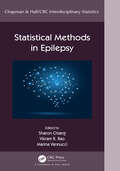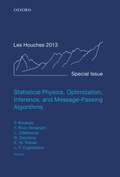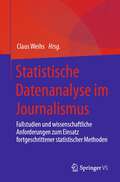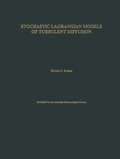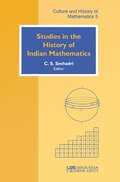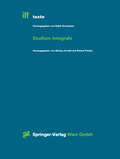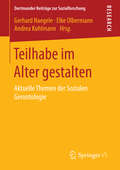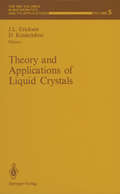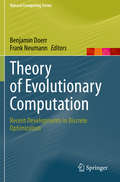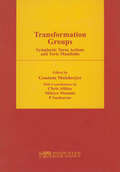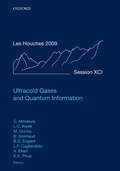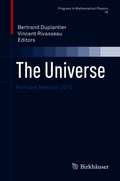- Table View
- List View
Statistical Inference in Stochastic Processes
Covering both theory and applications, this collection of eleven contributed papers surveys the role of probabilistic models and statistical techniques in image analysis and processing, develops likelihood methods for inference about parameters that determine the drift and the jump mechanism of a di
Statistical Methods in Epilepsy (Chapman & Hall/CRC Interdisciplinary Statistics)
Epilepsy research promises new treatments and insights into brain function, but statistics and machine learning are paramount for extracting meaning from data and enabling discovery. Statistical Methods in Epilepsy provides a comprehensive introduction to statistical methods used in epilepsy research. Written in a clear, accessible style by leading authorities, this textbook demystifies introductory and advanced statistical methods, providing a practical roadmap that will be invaluable for learners and experts alike.Topics include a primer on version control and coding, pre-processing of imaging and electrophysiological data, hypothesis testing, generalized linear models, survival analysis, network analysis, time-series analysis, spectral analysis, spatial statistics, unsupervised and supervised learning, natural language processing, prospective trial design, pharmacokinetic and pharmacodynamic modeling, and randomized clinical trials.Features: Provides a comprehensive introduction to statistical methods employed in epilepsy research Divided into four parts: Basic Processing Methods for Data Analysis; Statistical Models for Epilepsy Data Types; Machine Learning Methods; and Clinical Studies Covers methodological and practical aspects, as well as worked-out examples with R and Python code provided in the online supplement Includes contributions by experts in the field The handbook targets clinicians, graduate students, medical students, and researchers who seek to conduct quantitative epilepsy research. The topics covered extend broadly to quantitative research in other neurological specialties and provide a valuable reference for the field of neurology.
Statistical Physics, Optimization, Inference, and Message-Passing Algorithms: Lecture Notes of the Les Houches School of Physics: Special Issue, October 2013 (Lecture Notes of the Les Houches Summer School)
In the last decade, there have been an increasing convergence of interest and methods between theoretical physics and fields as diverse as probability, machine learning, optimization and compressed sensing. In particular, many theoretical and applied works in statistical physics and computer science have relied on the use of message passing algorithms and their connection to statistical physics of spin glasses. The aim of this book, especially adapted to PhD students, post-docs, and young researchers, is to present the background necessary for entering this fast developing field.
Statistische Datenanalyse im Journalismus: Fallstudien und wissenschaftliche Anforderungen zum Einsatz fortgeschrittener statistischer Methoden
Dieses Buch zeigt anhand von journalistischen Fallbeispielen, warum und wie fortgeschrittene statistische Analysemethoden eingesetzt werden können, um aussagekräftige journalistische Informationen aus Daten zu extrahieren. Gleichzeitig setzt das Buch einen Anforderungsrahmen für die datenjournalistische Arbeit bezüglich Datenkompetenz und -visualisierung, dem Einsatz von Algorithmen sowie daten-ethischen Anforderungen und der Überprüfung externer Studien. Ziel ist es, die Qualität und Aussagekraft datenjournalistischer Arbeiten zu verbessern, welche, neben der angemessenen Erfassung und Aufbereitung von Daten, wesentlich von einer adäquaten Datenanalyse abhängen. Aber wie statistisch arbeiten Datenjournalist:innen heute eigentlich? Und wie statistisch können oder sollten sie arbeiten, um den Ansprüchen ihrer Leserschaft in Sachen Verständlichkeit gerecht zu werden, auch mit Blick auf deren unterschiedliches mathematisch-statisches Vorwissen? Das Buch zielt darauf ab, diese Fragen zu beantworten, indem es weiterführende statistische Methoden anhand von Fallstudien untersucht. Es verdeutlicht, warum diese Methoden auch im journalistischen Kontext oftmals problemangemessener sind und tiefer gehende Erkenntnisse liefern als vereinfachte Analysen und Basismethoden. Die Fallstudien decken dabei die wichtigsten statistischen Methoden ab: Verteilungen und Tests, Klassifikation, Regression, Zeitreihenanalyse, Clusteranalyse, Analyse von sequentiellen Daten ohne direkten Zeitbezug, Verwendung von Vorwissen und geplante Studien.
Stochastic Analysis, Filtering, and Stochastic Optimization: A Commemorative Volume to Honor Mark H. A. Davis's Contributions
This volume is a collection of research works to honor the late Professor Mark H.A. Davis, whose pioneering work in the areas of Stochastic Processes, Filtering, and Stochastic Optimization spans more than five decades. Invited authors include his dissertation advisor, past collaborators, colleagues, mentees, and graduate students of Professor Davis, as well as scholars who have worked in the above areas. Their contributions may expand upon topics in piecewise deterministic processes, pathwise stochastic calculus, martingale methods in stochastic optimization, filtering, mean-field games, time-inconsistency, as well as impulse, singular, risk-sensitive and robust stochastic control.
Stochastic Differential Systems, Stochastic Control Theory and Applications: Proceedings of a Workshop, held at IMA, June 9-19, 1986 (The IMA Volumes in Mathematics and its Applications #10)
This IMA Volume in Mathematics and its Applications STOCHASTIC DIFFERENTIAL SYSTEMS, STOCHASTIC CONTROL THEORY AND APPLICATIONS is the proceedings of a workshop which was an integral part of the 1986-87 IMA program on STOCHASTIC DIFFERENTIAL EQUATIONS AND THEIR APPLICATIONS. We are grateful to the Scientific Committee: Daniel Stroock (Chairman) WendeIl Flerning Theodore Harris Pierre-Louis Lions Steven Orey George Papanicolaou for planning and implementing an exciting and stimulating year-long program. We es pecially thank WendeIl Fleming and Pierre-Louis Lions for organizing an interesting and productive workshop in an area in which mathematics is beginning to make significant contributions to real-world problems. George R. Seil Hans Weinberger PREFACE This volume is the Proceedings of a Workshop on Stochastic Differential Systems, Stochastic Control Theory, and Applications held at IMA June 9-19,1986. The Workshop Program Commit tee consisted of W.H. Fleming and P.-L. Lions (co-chairmen), J. Baras, B. Hajek, J.M. Harrison, and H. Sussmann. The Workshop emphasized topics in the following four areas. (1) Mathematical theory of stochastic differential systems, stochastic control and nonlinear filtering for Markov diffusion processes. Connections with partial differential equations. (2) Applications of stochastic differential system theory, in engineering and management sci ence. Adaptive control of Markov processes. Advanced computational methods in stochas tic control and nonlinear filtering. (3) Stochastic scheduling, queueing networks, and related topics. Flow control, multiarm bandit problems, applications to problems of computer networks and scheduling of complex manufacturing operations.
Stochastic Lagrangian Models of Turbulent Diffusion (Meteorological Monographs)
This book is intended to give atmospheric scientists a basic understanding of the physical and mathematical foundations of stochastic Lagrangian models of turbulent diffusion. It presents the reader with the historical context of the topic, and it provides definitions, criteria and applications for stochastic diffusion.
Studies in the History of Indian Mathematics (Culture And History Of Mathematics)
This volume is the outcome of a seminar on the history of mathematics held at the Chennai Mathematical Institute during January-February 2008 and contains articles based on the talks of distinguished scholars both from the West and from India. The topics covered include: (1) geometry in the oulvasatras; (2) the origins of zero (which can be traced to ideas of lopa in Paoini's grammar); (3) combinatorial methods in Indian music (which were developed in the context of prosody and subsequently applied to the study of tonal and rhythmic patterns in music); (4) a cross-cultural view of the development of negative numbers (from Brahmagupta (c. 628 CE) to John Wallis (1685 CE); (5) Kunnaka, Bhavana and Cakravala (the techniques developed by Indian mathematicians for the solution of indeterminate equations); (6) the development of calculus in India (covering the millennium-long history of discoveries culminating in the work of the Kerala school giving a complete analysis of the basic calculus of polynomial and trigonometrical functions); (7) recursive methods in Indian mathematics (going back to Paoini's grammar and culminating in the recursive proofs found in the Malayalam text Yuktibhaua (1530 CE)); and (8) planetary and lunar models developed by the Kerala School of Astronomy. The articles in this volume cover a substantial portion of the history of Indian mathematics and astronomy. This book will serve the dual purpose of bringing to the international community a better perspective of the mathematical heritage of India and conveying the message that much work remains to be done, namely the study of many unexplored manuscripts still available in libraries in India and abroad.
Studium Integrale (iff-Texte #6)
Verschiedene Versuche, ein "Studium Integrale" zu installieren, gelten heute unter WissenschaftlerInnen als gescheitert. Die Disziplinen sind derart vielfältig, sie sprengen jede Verbindung. Das Problem der Orientierung angesichts der Fülle bleibt jedoch bestehen. Eine Gruppe von WissenschaftlerInnen befasst sich seit einigen Jahren mit der Entwicklung eines "integrierenden" Studienprogramms; eines Programms, das in Ergänzung zu bestehenden Fachstudien den Blick über die jeweiligen Grenzen ermöglichen soll. Es wird davon ausgegangen, dass wissenschaftliche Allgemeinbildung eine gesellschaftliche Funktion erfüllt, die dringend gebraucht wird um einen vernünftigen Umgang mit Fach-Expertisen zu ermöglichen. Eine weitere Besonderheit des Programms wäre die Sichtbarmachung geistes- und naturwissenschaftlicher Kulturen, die über die Wissenschaften hinaus wirksam sind.
Surveys in Theoretical High Energy Physics - 2: Lecture Notes from SERC Schools (Texts and Readings in Physical Sciences #15)
The book presents pedagogical reviews of important topics on high energy physics to the students and researchers in particle physics. The book also discusses topics on the Quark–Gluon plasma, thermal field theory, perturbative quantum chromodynamics, anomalies and cosmology. Students of particle physics need to be well-equipped with basic understanding of many concepts underlying the standard models of particle physics and cosmology. This is particularly true today when experimental results from colliders, such as large hadron collider (LHC) and relativistic heavy ion collider (RHIC), as well as inferences from cosmological observations, are expected to further expand our understanding of particle physics at high energies. This volume is the second in the Surveys in Theoretical High Energy Physics Series (SThEP). Topics covered in this book are based on lectures delivered at the SERC Schools in Theoretical High Energy Physics at the Physical Research Laboratory, Ahmedabad, and the University of Hyderabad.
Symplectic Geometry: A Festschrift in Honour of Claude Viterbo’s 60th Birthday
Over the course of his distinguished career, Claude Viterbo has made a number of groundbreaking contributions in the development of symplectic geometry/topology and Hamiltonian dynamics. The chapters in this volume – compiled on the occasion of his 60th birthday – are written by distinguished mathematicians and pay tribute to his many significant and lasting achievements.
Teilhabe im Alter gestalten: Aktuelle Themen der Sozialen Gerontologie (Dortmunder Beiträge zur Sozialforschung)
Die AutorInnen dieses Sammelbandes untersuchen zentrale Themen der sozialen Gerontologie mit dem Blick auf Teilhabe im Alter: Armut und Lebensstandardsicherung, Migration, Wohnen, Bildung und Lernen, Mobilität, Technik, Seniorenwirtschaft, betriebliches Alternsmanagement, Erwerbsarbeit Älterer, informelle und formelle Unterstützungssysteme, Generationenbeziehungen, Vereinbarkeit von Erwerbstätigkeit und Pflege, gesundheitliche und pflegerische Versorgung, Personalbedarf in Altenarbeit und -pflege, quartiersbezogene Altenpolitik und -arbeit, Demografiekonzepte, politische und soziale Partizipation. Eingeordnet werden die Beiträge in die Zusammenhänge von Lebensqualität, sozialen Innovationen und Kritischer Gerontologie. Deutlich werden neue Sichtweisen auf das Alter sowie Herausforderungen und Perspektiven für Forschung, Praxis und Politik.
Theory and Applications of Liquid Crystals (The IMA Volumes in Mathematics and its Applications #5)
This IMA Volume in Mathematics and its Applications AMORPHOUS POLYMERS AND NON-NEWTONIAN FLUIDS is in part the proceedings of a workshop which was an integral part of the 1984-85 IMA program on CONTINUUM PHYSICS AND PARTIAL DIFFERENTIAL EQUATIONS We are grateful to the Scientific Committee: Haim Brezis Constantine Dafermos Jerry Eri cksen David Kinderlehrer for planning and implementing an exciting and stimulating year-long program. We espe cially thank the Program Organizers, Jerry Ericksen, David Kinderlehrer, Stephen Prager and Matthew Tirrell for organizing a workshop which brought together scientists and mathematicians in a variety of areas for a fruitful exchange of ideas. George R. Sell Hans Weinberger Preface The diversity of experimental phenomena and the range of applications of liquid crystals present timely and challenging questions for experimentalists, mechanists, and mathematicians. The scope of this workshop was to bring together research workers and practitioners in these areas from laboratories, industry, and universities to explore common issues. The contents of this volume vary from descriptions of experimental phenomena, of which our understanding is insufficient, to questions of a mathematical nature and of efficient computation.
Theory of Evolutionary Computation: Recent Developments in Discrete Optimization (Natural Computing Series)
This edited book reports on recent developments in the theory of evolutionary computation, or more generally the domain of randomized search heuristics. It starts with two chapters on mathematical methods that are often used in the analysis of randomized search heuristics, followed by three chapters on how to measure the complexity of a search heuristic: black-box complexity, a counterpart of classical complexity theory in black-box optimization; parameterized complexity, aimed at a more fine-grained view of the difficulty of problems; and the fixed-budget perspective, which answers the question of how good a solution will be after investing a certain computational budget. The book then describes theoretical results on three important questions in evolutionary computation: how to profit from changing the parameters during the run of an algorithm; how evolutionary algorithms cope with dynamically changing or stochastic environments; and how population diversity influences performance. Finally, the book looks at three algorithm classes that have only recently become the focus of theoretical work: estimation-of-distribution algorithms; artificial immune systems; and genetic programming. Throughout the book the contributing authors try to develop an understanding for how these methods work, and why they are so successful in many applications. The book will be useful for students and researchers in theoretical computer science and evolutionary computing.
Toeplitz Matrices, Asymptotic Linear Algebra and Functional Analysis (Texts and Readings in Mathematics #67)
Topics in Applied Analysis and Optimisation: Partial Differential Equations, Stochastic and Numerical Analysis (CIM Series in Mathematical Sciences)
This volume comprises selected, revised papers from the Joint CIM-WIAS Workshop, TAAO 2017, held in Lisbon, Portugal, in December 2017. The workshop brought together experts from research groups at the Weierstrass Institute in Berlin and mathematics centres in Portugal to present and discuss current scientific topics and to promote existing and future collaborations. The papers include the following topics: PDEs with applications to material sciences, thermodynamics and laser dynamics, scientific computing, nonlinear optimization and stochastic analysis.
Traffic and Granular Flow '22 (Lecture Notes in Civil Engineering #443)
This book gathers contributions on a variety of flowing collective systems. While primarily focusing on pedestrian dynamics, it also reflects the latest developments in areas such as vehicular traffic and granular flows and addresses related emerging topics such as self-propelled particles, data transport, swarm behaviour, intercellular transport, and individual interactions to complex systems. Combining fundamental research and practical applications in the various fields discussed, the book offers a valuable asset for researchers and professionals in areas such as civil and transportation engineering, mechanical engineering, electrical engineering, physics, computer science, and mathematics.
Translation
This diagram shows three triangles; the original triangle and its translation in two different ways to two new positions. A locator dot and title are shown. These must always be at the top left of the page when the image is the right way up. There is a graph with all four quadrants showing, and the x and y axes ranging from -3 to 3. The x and the y axes intersect at the origin marked by an O. Axes values are positive to the right and to the top of the diagram. Axes values are negative to the left and to the bottom of the diagram. Not all axis division marks are labelled. Some of the braille uses maths code notation. When a shape is translated, it stays the same shape and orientation; only its position changes. The original triangle is in the top left quadrant. There is a translation to the right of a value of 4, and then a translation down of a value of 1. There is also a second translation, right to a value of 4, and then down to a value of 4. The movement of the first triangle is indicated by a heavy dashed line.
Translation
This diagram shows three triangles; the original triangle and its translation in two different ways to two new positions. A locator dot and title are shown. These must always be at the top left of the page when the image is the right way up. There is a graph with all four quadrants showing, and the x and y axes ranging from -3 to 3. The x and the y axes intersect at the origin marked by an O. Axes values are positive to the right and to the top of the diagram. Axes values are negative to the left and to the bottom of the diagram. Not all axis division marks are labelled. Some of the braille uses maths code notation. When a shape is translated, it stays the same shape and orientation; only its position changes. The original triangle is in the top left quadrant. There is a translation to the right of a value of 4, and then a translation down of a value of 1. There is also a second translation, right to a value of 4, and then down to a value of 4. The movement of the first triangle is indicated by a heavy dashed line.
Transport in Transition Regimes (The IMA Volumes in Mathematics and its Applications #135)
This volume focuses on modeling processes for which transport is one of the most complicated components, requiring different transport models in each region. The authors apply questions to a wide variety of application areas, such as semiconductors, plasmas, fluids, chemically reactive gases, etc.
Transport Theory: Invariant Imbedding, and Integral Equations: Proceedings in Honor of G.m. Wing's 65th Birthday
This book includes seminal papers on technical subjects—transport theory, invariant imbedding, and integral equations—presented as contributions to honour George Milt Wing in celebration of his 65th birth anniversary in 1988.
Ultracold Gases and Quantum Information: Lecture Notes of the Les Houches Summer School in Singapore: Volume 91, July 2009 (Lecture Notes of the Les Houches Summer School)
In recent years, there has been much synergy between the exciting areas of quantum information science and ultracold atoms. This volume, as part of the proceedings for the XCI session of Les Houches School of Physics (held for the first time outside Europe in Singapore) brings together experts in both fields. The theme of the school focused on two principal topics: quantum information science and ultracold atomic physics. The topics range from Bose Einstein Condensates to Degenerate Fermi Gases to fundamental concepts in Quantum Information Sciences, including some special topics on Quantum Hall Effects, Quantum Phase Transition, Interactions in Quantum Fluids, Disorder and Interference Phenomenoma, Trapped Ions and Atoms, and Quantum Optical Devices.
The Universe: Poincaré Seminar 2015 (Progress in Mathematical Physics #76)
This volume provides a detailed description of some of the most active areas in astrophysics from the largest scales probed by the Planck satellite to massive black holes that lie at the heart of galaxies and up to the much awaited but stunning discovery of thousands of exoplanets. It contains the following chapters: • Jean-Philippe UZAN, The Big-Bang Theory: Construction, Evolution and Status • Jean-Loup PUGET, The Planck Mission and the Cosmic Microwave Background • Reinhard GENZEL, Massive Black Holes: Evidence, Demographics and Cosmic Evolution • Arnaud CASSAN, New Worlds Ahead: The Discovery of ExoplanetsReinhard Genzel and Andrea Ghez shared the 2020 Nobel Prize in Physics “for the discovery of a supermassive compact object at the centre of our galaxy’”, alongside Roger Penrose “for the discovery that black hole formation is a robust prediction of the general theory of relativity”. The book corresponds to the twentieth Poincaré Seminar, held on November 21, 2015, at Institut Henri Poincaré in Paris. Originally written as lectures to a broad scientific audience, these four chapters are of high value and will be of general interest to astrophysicists, physicists, mathematicians and historians.

